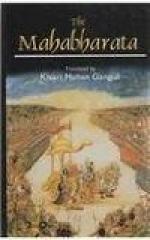beget sons in women taken from their own classes, those
sons take the status of their sires. It is only
when they take spouse from castes other than their
own, that the children they beget become invested
with inferior status. As an example of this it
may be said that a Sudra begets upon a woman belonging
to the most superior order a son that is outside the
pale of the four orders (for such a son comes to be
regarded as a Chandala who is much inferior).
The son that is outside the pale of the four orders
by uniting with women belonging to the four principal
orders, begets offspring that are further degraded
in point of status. From those outside the pale
of the four orders and those again that are further
outside that pale, children multiply in consequence
of the union of persons with women of classes superior
to their own. In this way, from persons of inferior
status classes spring up, altogether fifteen in number,
that are equally low or still lower in status.
It is only from sexual union of women with persons
who should not have such union with them that mixed
classes spring up. Among the classes that are
thus outside the pale of the four principal or pure
orders, children are begotten upon women belonging
to the class called Sairindhri by men of the class
called Magadha. The occupation of such offspring
is the adornment of the bodies of kinds and others.
They are well-acquainted with the preparation of unguents,
the making of wreaths, and the manufacture of articles
used for the decoration of the person. Though
free by the status that attaches to them by birth,
they should yet lead a life of service. From
the union of Magadhas of a certain class with women
of the caste called Sairindhri, there springs up another
caste called Ayogava. Their occupation consists
in the making of nets (for catching fish and fowl
and animals of the chase). Vaidehas, by uniting
themselves with women of the Sairindhri caste, beget
children called Maireyakas whose occupation consists
in the manufacture of wines and spirits. From
the Nishadas spring a caste called Madgura and another
known by the name of Dasas whose occupation consists
in plying boats. From the Chandala springs a
race called Swapaka whose occupation consists in keeping
guard over the dead. The women of the Magadhi
caste, by union with these four castes of wicked dispositions
produce four others who live by practising deceit.
These are Mansa, Swadukara, Kshaudra, and Saugandha.
From the Vaideha springs up a cruel and sinful caste
that lives by practising deception. From the
Nishadas again springs up the Madranabha caste whose
members are seen to ride on cars drawn by asses.
From the Chandalas springs up the caste called Pukkasa
whose members are seen to eat the flesh of asses,
horses and elephants. These cover themselves with
the garments obtained by stripping human corpses.
They are again seen to eat from broken earthenware[300].
These three castes of very low status are born of




